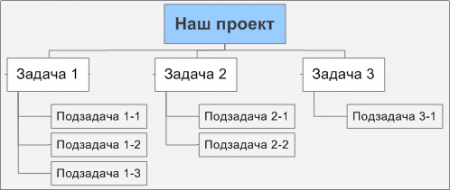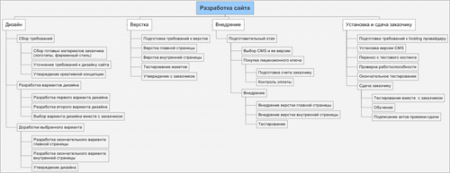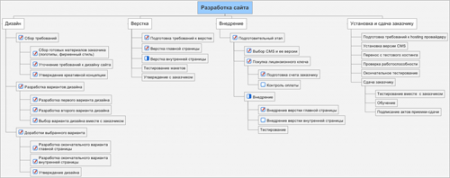Rescue for a project manager or building an ISR
Rescue of managers drowning in the project, the work of the managers themselves. It so happens that neither the management nor subordinate employees for some reason notice your gurgles and screams, in the end you suffer a crushing collapse and as the legendary Titanic go to the bottom. Why does this happen?
One of the common reasons is the loss of some of the necessary work from the view, attempts to further include them in an already tight schedule, which in the best case lead to overtime, overtime, behind schedule, and in the worst, to the total collapse of the project.
In order not to lose sight of anything, from the very beginning of the project it is worth paying as much attention as possible to the list of work to be done. But in linear, single-level lists, it's easy to get confused and lost. Here, the hierarchical structure of the project work comes to our aid , it is also the JIS .
The SRI is a work tree whose root is the entire project. First, we will analyze the SRI using abstract pictures as an example.
By the way, I like to draw such structures in the Mindjet MindManager. Although any other software for compiling mental maps and even Microsoft Visio will do. I personally like MindManager for its flexibility and pictograms and comments for individual nodes of the structure.
So, our project:

Let's say it consists of several tasks and subtasks:

The diagram clearly shows the relationship between tasks and subtasks. Accordingly, to complete Task 1, you need to complete 3 sub-tasks, and to complete the entire project, all 3 main tasks. This diagram is actually nothing more than a structural hierarchical decomposition of work. But, in a very convenient form.
The main rule for creating such a diagram is that any element can have only one parent. Only one and nothing more.
Let's move on from abstract examples to concrete ones. Let's take a simple example, let's say we need to develop a small site, and use some ready-made CMS for its foundation.
Our work will consist of the usual tasks for a simple site: design , layout layouts , their implementation in CMS and installation and delivery to the customer .

We will move on, trying to decompose the tasks into the smallest components, that is, we carry out the decomposition.

This diagram does not pretend to be objective and complete, because it was drawn up in 5 minutes, but should show the general direction of movement along the decomposition of tasks.
By the way, for large projects, you can not try to draw such a diagram in one step. It is enough just to move from top to bottom and constantly keep it in an updated state in accordance with the current situation in the project. Using such a diagram it is very easy to make a number of useful, and sometimes necessary things:

Original: Rescue for a project manager or building an ISR
One of the common reasons is the loss of some of the necessary work from the view, attempts to further include them in an already tight schedule, which in the best case lead to overtime, overtime, behind schedule, and in the worst, to the total collapse of the project.
In order not to lose sight of anything, from the very beginning of the project it is worth paying as much attention as possible to the list of work to be done. But in linear, single-level lists, it's easy to get confused and lost. Here, the hierarchical structure of the project work comes to our aid , it is also the JIS .
The SRI is a work tree whose root is the entire project. First, we will analyze the SRI using abstract pictures as an example.
By the way, I like to draw such structures in the Mindjet MindManager. Although any other software for compiling mental maps and even Microsoft Visio will do. I personally like MindManager for its flexibility and pictograms and comments for individual nodes of the structure.
So, our project:

Let's say it consists of several tasks and subtasks:

The diagram clearly shows the relationship between tasks and subtasks. Accordingly, to complete Task 1, you need to complete 3 sub-tasks, and to complete the entire project, all 3 main tasks. This diagram is actually nothing more than a structural hierarchical decomposition of work. But, in a very convenient form.
The main rule for creating such a diagram is that any element can have only one parent. Only one and nothing more.
Let's move on from abstract examples to concrete ones. Let's take a simple example, let's say we need to develop a small site, and use some ready-made CMS for its foundation.
Our work will consist of the usual tasks for a simple site: design , layout layouts , their implementation in CMS and installation and delivery to the customer .

We will move on, trying to decompose the tasks into the smallest components, that is, we carry out the decomposition.

This diagram does not pretend to be objective and complete, because it was drawn up in 5 minutes, but should show the general direction of movement along the decomposition of tasks.
By the way, for large projects, you can not try to draw such a diagram in one step. It is enough just to move from top to bottom and constantly keep it in an updated state in accordance with the current situation in the project. Using such a diagram it is very easy to make a number of useful, and sometimes necessary things:

- Do not forget about tasks, especially critical of which can be noted in a different color;
Mark the completion of certain tasks (as in the figure above) - Make an assessment of the project, and if we go from bottom to top, we can make an accurate assessment, and if from top to bottom, we can remove some tasks to fit the project to a specific budget.
- Mark the performers on this diagram and do not forget about the warning (or booking) of the people necessary for the project.
- Outline the supply plan, in the case of a large project, highlighting the finished pieces (in this diagram it can be design, layout, implementation and installation)
- From such a diagram it is very easy to go to a calendar network diagram and the Gantt chart so beloved by many
Original: Rescue for a project manager or building an ISR
